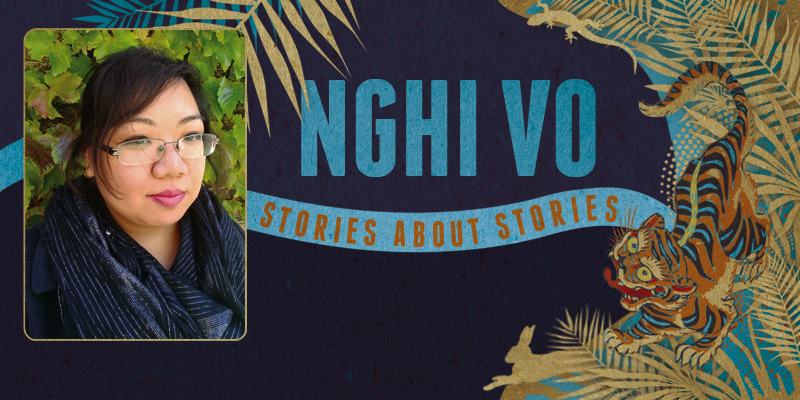Nghi Vo: Stories About Stories

Nghi Dong Vo was born December 4, 1981 in Peoria IL. She lived there until attending college at the University of Illinois in Urbana-Champaign, where she studied political science and media studies. In 2007 she settled in Milwaukee WI.
Vo’s first story was “Gift of Flight” in 2007, and she has since published almost 20 stories in various publications. Her first book was Crawford Award winning novella The Empress of Salt and Fortune (2020), beginning the Singing Hills series, followed by novella When the Tiger Came Down the Mountain (2020); a third in the sequence is forthcoming.
Her debut novel, The Chosen and the Beautiful (2021) is a magical retelling of F. Scott Fitzgerald’s The Great Gatsby. Historical fantasy Siren Queen will be out in 2022.
Excerpts from the interview:
“I keep telling people I’m going to be useless for anything because my entire publishing career has taken place within the pandemic. My debut came out within about two days of a national lockdown. I keep telling Diana, my agent, ‘I’m going to be like a feral writer.’ It’s like, ‘No, no, she can’t do events. Don’t touch her – she doesn’t know enough to do that.’ It’s going to be interesting to see what happens as the world progresses, and hopefully as my career goes with. ‘What do you mean I can’t do these things over Zoom anymore?’
“Being a writer wasn’t really a choice. Whatever I was going to do, I was going to be writing. It might have been stories that only I ever saw, or just fanfiction. Writing was always a presence, and then I thought, ‘Wow, I could get money for this. I like money.’ It just rolled on from there.
“When I was growing up, I mostly gravitated toward books with pretty covers that I got from garage sales. The nice thing about science fiction and fantasy is they have the best covers if you’re a little kid, and picking based on covers has seldom steered me wrong. That’s how I got into some classic SF and fantasy. It’s also how I ended up reading Red Dragon by Tom Harris, the prequel to Silence of the Lambs, way too early, so going by covers is not the best technique in the world. It was formative – let’s put it that way.
“The first thing I published was a limerick when I was nine in the kids’ section of my local newspaper. They didn’t pay me for it, but that would come later. I’ve been a writer for most of my adult life. It’s been a weird, varied career. I’ve been a ghostwriter and a copywriter. I have written various guides for people from freelancing sites, you know, vacuum cleaner parts, cockroach care guides, things like that. I actually gave myself a cockroach phobia when I didn’t have one before, after writing a guide for a very sweet human being who really wanted to give me all these photos and details about how to raise cockroaches. I took one writing class in college, back around 2002. It didn’t go terribly well. A couple years later I made my first professional sale to Strange Horizons, which was deeply exciting. I love Strange Horizons – they have a very special place in my heart just for that, and because their editorial team has always been wonderful.
“The magic of a short story is it’s done in about a week. It sounds like I’m joking, but that’s real. I don’t have an amazing attention span, and honestly I work best with boundaries. I love speculative fiction as the genre without limits, but that can be deeply paralyzing sometimes. If I have all of space and time to play with, then I start getting nervous. When it comes to something that’s only, say, 2,000 to 7,000 words long, there is only so much damage I can do to myself or to someone else.
“The Empress of Salt and Fortune was my first novella. At the time it was the longest piece of personal fiction I had ever written. When you’re a ghostwriter or a copywriter, you are very conscious of word count. I’d heard about the Tordotcom novella line, and somehow the number 20,000 clicked in my head. I thought, ‘20,000 words. That’s only, like, four short stories strung together and then made larger. I can do 20,000 words.’ That’s when I wrote The Empress of Salt and Fortune.
“The Empress of Salt and Fortune comes from a lot of places. I was trying to do a lot of things in a very small amount of space. One of the most deeply flattering things I heard when the reviews for Empress were coming out was that I managed to fit a multi-book fantasy epic into about 100 pages. There was a story in my head, and there was a format I wanted to fit it into. The story started out as a poem but, as it turns out, I’m a very bad poet, so I quickly moved on. The idea was in my head for a long time before Tor’s novella program came along. When that happened, it was a matter of being in the right place at the right time. I decided I could probably handle it. I spent a couple of years volunteering at an art museum in Milwaukee, seeing all of those tiny plaques all over the place. I thought, ‘These plaques are not really enough to explain to me exactly why someone created a sculpture entirely out of clear acrylic buttons.’ It’s the coolest sculpture – unfortunately the name slips my mind, but it’s weird, and I just couldn’t figure it out. I feel like there’s a lot that goes into why that piece is so cool or why someone would choose to make it. That’s where the idea for the museum formatting of Empress comes from.
“Chih is the narrator of The Empress of Salt and Fortune. (At some point, people are going to figure out that Chih is at least a little manipulative, and I think that’s going to break some people’s hearts. They’re there with an agenda.) Chih came along quite a bit after the genesis of the story and after I started figuring out how I was going to write it. Rabbit was always there, and In-Yo was always there, but Rabbit needed someone to talk to. Who could Rabbit talk to? The answer became Chih, a nonbinary historian monk who is basically on pilgrimage and just happens to stop by. That’s how Chih started.
“I just sent off the third Singing Hills novella – the second one’s already out, When Tiger Came Down the Mountain. I really hope I get to spend a lot of time with Chih going forward. The more I learn about Chih, the more I realize they snuck up on me. I usually don’t write characters as nice as Chih is. A lot more of my characters are like In-Yo – they’re more ruthless, because they’ve had more taken away from them and learned to survive that, and they’ve learned to force other people to survive, too.
“The second volume, When the Tiger Came Down the Mountain, is about Chih – without Almost Brilliant this time – traveling through the northern countries with a mammoth scout and her mammoth. They’re ambushed by tigers, and have to spend the night telling stories to survive. It’s a dueling narrative, with Chih telling part of the story and the tiger that is menacing them telling the other half of the story.
“In the first book Chih is mostly recording and doing their life’s work as an archivist, essentially, and a researcher – their world’s version of an anthropologist in a lot of ways. The Empress of Salt and Fortune was my first novella, and my first big sale. It’s my first book, so it was a little harrowing when I started seeing all these reviews of When the Tiger Came Down the Mountain where people were saying, ‘This is a very different story from Empress.’ I thought, ‘Please like it as much, please?’ It’s actually been doing just fine, and I’m doing fine, but they were always going to be very different books. When I realized I could just follow Chih through their career, I wanted to do that. If the Singing Hills stories have a theme, it’s that they’re stories about stories: how we tell stories and why we tell stories, and where we get it wrong and where we get it right, even when the stories aren’t real or true. When the third volume comes out, I think it will help people see the whole scope of the series, because we’re going back and forth in Chih’s timeline, so back and forth in history. There are some Easter eggs that I’ve thrown in here and there – Wantai Mai, the fox girl, is in both Empress and Tiger. She’s just going to keep showing up, no matter where in history we are and no matter what we’re doing. She’s there somewhere, causing trouble. It’s going to be fun. I’m asking people to sit with me for about 100 pages, and just trust me that, whatever I’m telling them, they’re going to have a good time. That’s my hope.
“The first novel I wrote, Siren Queen, now holds the record for the longest thing I’ve ever written – that’s coming out from Tordotcom next year. I wrote Siren Queen because Angry Robot had a contest open to unagented writers, and I apparently got very close, which made me think, ‘If I’m getting close, I should start sending this to publishers while I’m doing other things.’ I’m a pretty good multitasker. The whole genesis of Siren Queen was realizing I can actually write that number of words and make it a coherent story, so let’s go from there. Historically, it was always funny to me to think that short stories were once how you made a living with writing, and now it’s completely changed. Short stories are now the fun experimental form, and if you want to make a living writing, you have to do novels. Writing books is a different skill set, and it’s one that needs to be learned and figured out.”
Vo interview art by Francesca Myman with tiger based on art by Jane Cho of Outer Limits Tattoo. Photo by Francesca Myman.
Read the full interview in the May 2021 issue of Locus.
 While you are here, please take a moment to support Locus with a one-time or recurring donation. We rely on reader donations to keep the magazine and site going, and would like to keep the site paywall free, but WE NEED YOUR FINANCIAL SUPPORT to continue quality coverage of the science fiction and fantasy field.
While you are here, please take a moment to support Locus with a one-time or recurring donation. We rely on reader donations to keep the magazine and site going, and would like to keep the site paywall free, but WE NEED YOUR FINANCIAL SUPPORT to continue quality coverage of the science fiction and fantasy field.
©Locus Magazine. Copyrighted material may not be republished without permission of LSFF.






